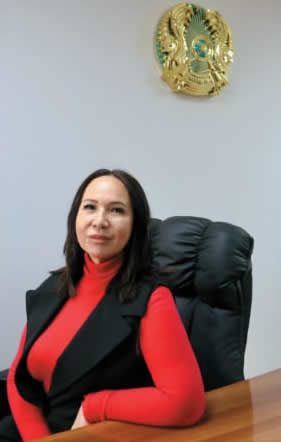FEMALE LEADERSHIP IN KAZAKHSTAN’S ENERGY INDUSTRY
We Follow the Fate of Each of Our Participants
An Interview with Aizada Akkaisiyeva, Chairperson of the KAZENERGY Women’s Energy Club

– Aizada Umbetovna, what primarily defines your club: a hobby group? A lobbying structure?
– The Women’s Energy Club is primarily a union of women engaged in the energy sector of the Republic of Kazakhstan, interested in improving the socio-political, socio-economic, and cultural-spiritual position of women in the country, as well as in strengthening women's roles and expanding their opportunities in production. It is a platform for sharing experiences and assisting each other.
– Could you tell us more about the history of this union’s inception?
– In 2012, I was invited to join the National Commission on Women's Affairs and Family-Demographic Policy under the President of the Republic of Kazakhstan, where the proposal was made to open a women's association in the oil industry, uniting women in energy to create a platform for exchanging experiences and nurturing women leaders in this "non-female" industry. In September 2013, after consulting with female colleagues, we decided that the best solution would be to open a Women's Club under the auspices of the KAZENERGY Association, which includes almost 100 oil and energy companies.
And now, for over ten years, this organization has been established and recognized. We participate in many international projects and all our country's legislative initiatives. This is a union of all women in the oil industry in energy. Women working in companies that are part of the KAZENERGY Association are automatically members of the Women's Energy Club.
Let's say we keep an eye on every woman with leadership qualities. Under our auspices, the first women's MBA program was opened last year at the Atyrau University of Oil and Gas, where many of our women leaders teach and serve as mentors for many girls. We have two committees: a mentoring committee and a committee for working with international organizations.
The Women's Club executive committee comprises about twenty women leaders of KAZENERGY companies who are part of decision-making bodies, including board members, supervisory boards, and independent directors on company boards.
We also "follow" the fate of every female leader in the industry, assist when necessary, provide training, and give recommendations. Practically no appointment to management bodies is made without our recommendation, if not in writing, at least verbally. Employers turn to us and ask for our opinion on one candidate or another.
– Women in the oil and gas, energy sectors: who are they?
– Like any other, the oil and gas sector cannot do without lawyers, financiers, accountants, and many other professionals who work hard in their positions and are considered part of the oil community. In these fields, many women have reached certain heights, exemplified by the national company KazMunayGas and its subsidiaries, NCOC, KPO, TCO, and many others, where women hold positions of managing directors, department directors, and other high-ranking posts.
One of the striking examples of female participation and leadership in the oil and gas industry is the scientific research and design institutes (SRDIs), where primarily (about 60%) women work, taking on leading roles from general directors and their deputies to heads of departments, divisions, and laboratories.
Women's role in research activities is significant as they are involved in all processes without which no decision is made to explore a promising area, start drilling an exploration or production well, develop new fields, and optimize production at developed sites.
– Do you think there is a so-called glass ceiling in women's careers?
– The glass ceiling still exists, thanks to gender stereotypes rooted in public consciousness. The problem is that they act as "unwritten norms" that often go unnoticed, even by women themselves.
An increasing number of studies show that expanding women's participation in the workforce, especially in leadership positions, offers companies a range of specific benefits, from an expanded talent pool for recruitment to improved financial and corporate governance efficiency.
Considering the productivity growth associated with increasing gender equality, leading companies increasingly aim to develop policies and practices to attract more women to the workforce and develop and retain the most talented women.



